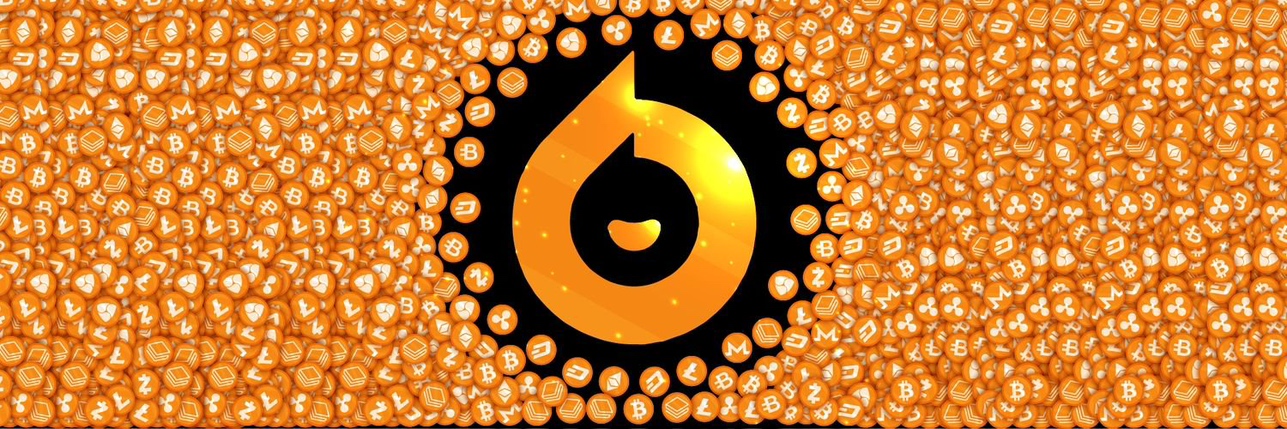Bitget:全球日交易量排名前 4!
BTC 市占率63.01%
Bitget 新幣上架 : Pi
BTC/USDT$108492.01 (-0.06%)恐懼與貪婪指數71(貪婪)
山寨季指數:0(比特幣季)
盤前交易幣種SOONNEW比特幣現貨 ETF 總淨流量:-$23.9M(1 天);+$2.73B(7 天)。Bitget 新用戶立享 6,200 USDT 歡迎禮包!立即領取
到 Bitget App 隨時隨地輕鬆交易!立即下載
Bitget:全球日交易量排名前 4!
BTC 市占率63.01%
Bitget 新幣上架 : Pi
BTC/USDT$108492.01 (-0.06%)恐懼與貪婪指數71(貪婪)
山寨季指數:0(比特幣季)
盤前交易幣種SOONNEW比特幣現貨 ETF 總淨流量:-$23.9M(1 天);+$2.73B(7 天)。Bitget 新用戶立享 6,200 USDT 歡迎禮包!立即領取
到 Bitget App 隨時隨地輕鬆交易!立即下載
Bitget:全球日交易量排名前 4!
BTC 市占率63.01%
Bitget 新幣上架 : Pi
BTC/USDT$108492.01 (-0.06%)恐懼與貪婪指數71(貪婪)
山寨季指數:0(比特幣季)
盤前交易幣種SOONNEW比特幣現貨 ETF 總淨流量:-$23.9M(1 天);+$2.73B(7 天)。Bitget 新用戶立享 6,200 USDT 歡迎禮包!立即領取
到 Bitget App 隨時隨地輕鬆交易!立即下載



BLUE/TWD 匯率換算器
BLUE
TWD
1 BLUE = 3.89 TWD,目前 1 Bluefin(BLUE)兌換 TWD 的價格為 3.89。匯率即時更新,僅供參考。
在所有主流交易平台中,Bitget 提供最低的交易手續費。VIP 等級越高,費率越優惠。
Bluefin價格走勢圖 (BLUE/TWD)
最近更新時間 2025-05-28 02:30:33(UTC+0)
市值:NT$1,188,988,371.09
完全稀釋市值:NT$1,188,988,371.09
24 小時交易額:NT$1,486,326,601.5
24 小時交易額/市值:125.00%
24 小時最高價:NT$4.01
24 小時最低價:NT$3.77
歷史最高價:NT$25.17
歷史最低價:NT$1.72
流通量:305,592,960 BLUE
總發行量:
1,000,000,000BLUE
流通率:30.00%
最大發行量:
1,000,000,000BLUE
以 BTC 計價:0.{5}1198 BTC
以 ETH 計價:0.{4}4957 ETH
以 BTC 市值計價:
NT$211,148.26
以 ETH 市值計價:
NT$31,008.6
合約:--
您認為今天 Bluefin 價格會上漲還是下跌?
總票數:
上漲
0
下跌
0
投票數據每 24 小時更新一次。它反映了社群對 Bluefin 的價格趨勢預測,不應被視為投資建議。
Bluefin 的 AI 分析報告
今日加密市場熱點查看報告
今日Bluefin即時價格TWD
今日 Bluefin 即時價格為 NT$3.89 TWD,目前市值為 NT$1.19B。過去 24 小時內,Bluefin 價格漲幅為 3.04%,24 小時交易量為 NT$1.49B。BLUE/TWD(Bluefin 兌換 TWD)兌換率即時更新。
1Bluefin的價值是多少?
截至目前,Bluefin(BLUE)的 價格為 NT$3.89 TWD。您現在可以用 1 BLUE 兌換 NT$3.89,或用 NT$ 10 兌換 2.570193035549788 BLUE。在過去 24 小時內,BLUE 兌換 TWD 的最高價格為 NT$4.01 TWD,BLUE 兌換 TWD 的最低價格為 NT$3.77 TWD。
Bluefin價格歷史(TWD)
過去一年,Bluefin價格上漲了 -41.79%。在此期間,BLUENEW兌TWD 的最高價格為 NT$25.17,BLUENEW兌TWD 的最低價格為 NT$1.72。
時間漲跌幅(%) 最低價
最低價 最高價
最高價 
 最低價
最低價 最高價
最高價 
24h+3.04%NT$3.77NT$4.01
7d+21.77%NT$3.18NT$4.59
30d+7.49%NT$2.74NT$4.59
90d+4.90%NT$1.72NT$4.59
1y-41.79%NT$1.72NT$25.17
全部時間-57.39%NT$1.72(2025-04-07, 51 天前 )NT$25.17(2024-12-15, 164 天前 )
Bluefin的最高價格是多少?
Bluefin兌換TWD的歷史最高價(ATH)為 NT$25.17,發生於 2024-12-15。相較於價格回撤了 84.54%。
Bluefin的最低價格是多少?
Bluefin兌換TWD的歷史最低價(ATL)為 NT$1.72,發生於 2025-04-07。相較於Bluefin歷史最低價,目前Bluefin價格上漲了 126.18%。
Bluefin價格預測
什麼時候是購買 BLUE 的好時機? 我現在應該買入還是賣出 BLUE?
在決定買入還是賣出 BLUE 時,您必須先考慮自己的交易策略。長期交易者和短期交易者的交易活動也會有所不同。Bitget BLUE 技術分析 可以提供您交易參考。
根據 BLUE 4 小時技術分析,交易訊號為 強力買入。
根據 BLUE 1 日技術分析,交易訊號為 強力買入。
根據 BLUE 1 週技術分析,交易訊號為 強力買入。
BLUE 在 2026 的價格是多少?
根據BLUE的歷史價格表現預測模型,預計BLUE的價格將在 2026 達到 NT$4.25。
BLUE 在 2031 的價格是多少?
2031,BLUE的價格預計將上漲 +45.00%。 到 2031 底,預計BLUE的價格將達到 NT$10.04,累計投資報酬率為 +159.27%。
熱門活動
常見問題
Bluefin 的目前價格是多少?
Bluefin 的即時價格為 NT$3.89(BLUE/TWD),目前市值為 NT$1,188,988,371.09 TWD。由於加密貨幣市場全天候不間斷交易,Bluefin 的價格經常波動。您可以在 Bitget 上查看 Bluefin 的市場價格及其歷史數據。
Bluefin 的 24 小時交易量是多少?
在最近 24 小時內,Bluefin 的交易量為 NT$1.49B。
Bluefin 的歷史最高價是多少?
Bluefin 的歷史最高價是 NT$25.17。這個歷史最高價是 Bluefin 自推出以來的最高價。
我可以在 Bitget 上購買 Bluefin 嗎?
可以,Bluefin 目前在 Bitget 的中心化交易平台上可用。如需更詳細的說明,請查看我們很有幫助的 如何購買 bluefin 指南。
我可以透過投資 Bluefin 獲得穩定的收入嗎?
當然,Bitget 推出了一個 機器人交易平台,其提供智能交易機器人,可以自動執行您的交易,幫您賺取收益。
我在哪裡能以最低的費用購買 Bluefin?
Bitget提供行業領先的交易費用和市場深度,以確保交易者能够從投資中獲利。 您可通過 Bitget 交易所交易。
Bluefin 資訊
Bluefin持幣分布集中度
巨鯨
投資者
散戶
Bluefin地址持有時長分布
長期持幣者
游資
交易者
coinInfo.name(12)即時價格表

全球Bluefin價格
目前Bluefin用其他貨幣計價是多少?最近更新時間:2025-05-28 02:30:33(UTC+0)
BLUE 兌換 MXN
Mexican Peso
Mex$2.5BLUE 兌換 GTQGuatemalan Quetzal
Q1BLUE 兌換 CLPChilean Peso
CLP$122.05BLUE 兌換 UGXUgandan Shilling
Sh474.21BLUE 兌換 HNLHonduran Lempira
L3.39BLUE 兌換 ZARSouth African Rand
R2.33BLUE 兌換 TNDTunisian Dinar
د.ت0.39BLUE 兌換 IQDIraqi Dinar
ع.د170.25BLUE 兌換 TWDNew Taiwan Dollar
NT$3.9BLUE 兌換 RSDSerbian Dinar
дин.13.43BLUE 兌換 DOPDominican Peso
RD$7.65BLUE 兌換 MYRMalaysian Ringgit
RM0.55BLUE 兌換 GELGeorgian Lari
₾0.36BLUE 兌換 UYUUruguayan Peso
$5.41BLUE 兌換 MADMoroccan Dirham
د.م.1.2BLUE 兌換 AZNAzerbaijani Manat
₼0.22BLUE 兌換 OMROmani Rial
ر.ع.0.05BLUE 兌換 SEKSwedish Krona
kr1.25BLUE 兌換 KESKenyan Shilling
Sh16.8BLUE 兌換 UAHUkrainian Hryvnia
₴5.42- 1
- 2
- 3
- 4
- 5
相關加密貨幣價格
dogwifhat 價格(TWD)Kaspa 價格(TWD)Smooth Love Potion 價格(TWD)Terra 價格(TWD)Shiba Inu 價格(TWD)Dogecoin 價格(TWD)Pepe 價格(TWD)Cardano 價格(TWD)Bonk 價格(TWD)Toncoin 價格(TWD)Pi 價格(TWD)Fartcoin 價格(TWD)Bitcoin 價格(TWD)Litecoin 價格(TWD)WINkLink 價格(TWD)Solana 價格(TWD)Stellar 價格(TWD)XRP 價格(TWD)OFFICIAL TRUMP 價格(TWD)Ethereum 價格(TWD)
Bitget 平台新上架幣種的價格
新幣榜
如何購買Bluefin(BLUE)

建立您的免費 Bitget 帳戶
使用您的電子郵件地址/手機號碼在 Bitget 註冊,並建立強大的密碼以確保您的帳戶安全

認證您的帳戶
輸入您的個人資訊並上傳有效的身份照片進行身份認證

將 BLUE 兌換為 TWD
在 Bitget 上選擇加密貨幣進行交易。
了解更多購買其他幣種
您可以在哪裡購買Bluefin(BLUE)?
影片部分 - 快速認證、快速交易

如何在 Bitget 完成身分認證以防範詐騙
1. 登入您的 Bitget 帳戶。
2. 如果您是 Bitget 的新用戶,請觀看我們的教學,以了解如何建立帳戶。
3. 將滑鼠移到您的個人頭像上,點擊「未認證」,然後點擊「認證」。
4. 選擇您簽發的國家或地區和證件類型,然後根據指示進行操作。
5. 根據您的偏好,選擇「手機認證」或「電腦認證」。
6. 填寫您的詳細資訊,提交身分證影本,並拍攝一張自拍照。
7. 提交申請後,身分認證就完成了!
加密貨幣投資(包括透過 Bitget 線上購買 Bluefin)具有市場風險。Bitget 為您提供購買 Bluefin 的簡便方式,並且盡最大努力讓用戶充分了解我們在交易所提供的每種加密貨幣。但是,我們不對您購買 Bluefin 可能產生的結果負責。此頁面和其包含的任何資訊均不代表對任何特定加密貨幣的背書認可,任何價格數據均採集自公開互聯網,不被視為來自Bitget的買賣要約。
BLUE/TWD 匯率換算器
BLUE
TWD
1 BLUE = 3.89 TWD,目前 1 Bluefin(BLUE)兌換 TWD 的價格為 3.89。匯率即時更新,僅供參考。
在所有主流交易平台中,Bitget 提供最低的交易手續費。VIP 等級越高,費率越優惠。
Bluefin評級
社群的平均評分
4.6
此內容僅供參考。
Bitget 觀點

Asiftahsin
10小時前
Quant extends gains, aiming for $120, as risk-on sentiment returns :
Quant rises for the second straight day, trading above $100, supported by increasing risk appetite among large-volume holders.
QNT's daily active addresses jump to 1,000, signaling network growth and user engagement.
The MACD validates Quant's uptrend with a buy signal, but the near-overbought RSI cautions traders to temper expectations.
Quant's (QNT) price hovers around $109 at the time of writing on Tuesday, with intraday gains nearing 5%, supported by strong sentiment in the broader crypto market and growing interest among investors, particularly large-volume holders.
Quant enters accumulation phase
The bullish momentum propelling Quant's price above $100 likely emanates from the increasing risk-on sentiment among whales. Santiment's on-chain data shows a sharp increase in the percentage of supply held by addresses holding between 100,000 and 1 million coins.
This cohort of QNT holders currently accounts for approximately 32% of the total supply, up from around 30% on May 5. The yellow line on the chart below shows two short-lived peaks above 32% on May 19 and May 22, suggesting active profit-taking even as Quant's price extends gains.
The token's performance on-chain has also been on the rise, with the number of daily active addresses increasing from 720 on Sunday to 1,059 on Monday, representing a 32% rise.
Notably, the Daily Active Addresses metric, which tracks the unique addresses that transact QNT daily on the protocol, is also rising. This tool can be used to gauge the level of user engagement and speculation. A consistent increase in this metric often signals improving confidence among investors, which translates to a boost in demand for the token.
At the same time, the number of new addresses joining the blockchain protocol has gradually increased to 298 from approximately 107 on April 5, despite noticeable volatility in recent weeks. The 64% surge in the number of newly created addresses signals growing network adoption, which could steady the ongoing uptrend as demand for QNT increases.
Technical outlook: Quant upholds bullish structure
Quant's price is approaching the short-term resistance at $110 as part of a larger recovery, targeting highs above $120. The token sits on top of key levels such as the upper descending trendline and the confluence support area between $87 and $90, bringing together the 50-day Exponential Moving Average (EMA), the 100-day EMA and the 200-day EMA.
A buy signal from the Moving Average Convergence Divergence (MACD) indicator validated on Monday backs the uptrend. The signal occurred when the blue MACD line crossed above the red signal line.
Traders would look out for the MACD's continued uptrend above the mean line to ascertain the bullish momentum in upcoming sessions and days. If the MACD reverses toward the center line, it will imply fading bullish momentum amid potential profit-taking.
Still, the near-overbought Relative Strength Index (RSI) at 69 signals caution for traders, as overbought conditions are often a precursor to potential pullbacks. That said, a break above the immediate $110 resistance could reinforce the bullish grip on QNT, bringing the next key level at $120 into sight.
On the other hand, key monitoring levels on the downside range from near-term support at $100, which was tested as resistance on May 22, to the confluence zone between $87 and $90, as well as the demand area at $73, which was tested as the 50-day EMA in late April.
$QNT
RED-2.71%
BLUE+0.07%

Bpay-News
18小時前
Analysis: Four major indicators show that Bitcoin has not yet reached its peak, and the price of this cycle may exceed $200,000
According to Lookonchain analysis, the four major technical indicators all show that BTC has not yet reached the peak of this bull market. The rainbow chart predicts that the price of Bitcoin is expected to exceed $200,000 in this cycle; the RSI index is 71.35, which still has room to rise compared to the historical peak; the 200-week moving average heat map is in the blue area, indicating that the price has not yet reached the top; the 2-year moving average multiplier shows that the current price is between the red and green lines, and has not reached the top signal.
BTC-0.43%
MAJOR-2.82%

0xHades
21小時前
One of the potential blue-chip pick as first mover in RISC-V tech
Chart shows @QuantumFusion_ is close to strong support and buyers here will be celebrating in next few months.
We are seeing ETH memes running, next is the fundamental projects where the big volume will come in next.
Don't fade $QF, secure your entry.
ETH-1.44%
BLUE+0.07%

ツ
21小時前
Gib the based blue watch @jessepollak @brian_armstrong @WilsonCusack 👉👈
BLUE+0.07%
Anot
1天前
Creating a live 3D simulation of a rocket traveling from Earth to Mars using real orbital dynamics is a complex task that involves modeling the gravitational interactions and visualizing the trajectory. Below, I’ll provide a complete Python solution that simulates this journey using simplified orbital dynamics and visualizes the result with Matplotlib. This simulation assumes circular orbits for Earth and Mars around the Sun and uses a two-body approximation for the rocket’s motion under the Sun’s gravity. For a fully accurate model, one would need ephemeris data and N-body simulations, but this simplified approach captures the essence of the request.
Step-by-Step Solution
Model the Celestial Bodies:
Earth and Mars follow circular orbits around the Sun.
Their positions are calculated based on their orbital radii and periods.
Simulate the Rocket’s Trajectory:
The rocket launches from Earth’s position with an initial velocity.
Its motion is governed by the Sun’s gravitational force, solved using numerical integration.
Visualize the Trajectory:
A 3D plot shows the paths of Earth, Mars, and the rocket over time.
Python Code
Here’s the complete code to simulate and visualize the rocket’s journey:
python
import numpy as np
from scipy.integrate import
import matplotlib.pyplot as plt
from mpl_toolkits.mplot3d import Axes3D
# Constants
G = 6.67430e-11 # Gravitational constant (m^3 kg^-1 s^-2)
M_sun = 1.989e30 # Mass of the Sun (kg)
AU = 1.496 # Astronomical Unit (m)
# Orbital parameters
r_earth = 1.0 * AU # Earth's orbital radius (m)
r_mars = 1.524 * AU # Mars' orbital radius (m)
T_earth = 365.25 * 24 * 3600 # Earth's orbital period (s)
T_mars = 687.0 * 24 * 3600 # Mars' orbital period (s)
# Angular velocities
omega_earth = 2 * np.pi / T_earth
omega_mars = 2 * np.pi / T_mars
# Time array
t_max = 0.5 * T_earth # Simulate for half an Earth year (adjustable)
dt = 3600 # Time step of 1 hour
t = np.arange(0, t_max, dt)
# Positions of Earth and Mars (circular orbits in the XY plane)
theta_earth = omega_earth * t
theta_mars = omega_mars * t
earth_pos = np.array([r_earth * np.cos(theta_earth), r_earth * np.sin(theta_earth), np.zeros_like(t)])
mars_pos = np.array([r_mars * np.cos(theta_mars), r_mars * np.sin(theta_mars), np.zeros_like(t)])
# Rocket initial conditions
initial_pos = earth_pos[:, 0] # Start at Earth's initial position
v_escape = np.sqrt(2 * G * M_sun / r_earth) # Escape velocity from Sun at Earth's distance
direction = (mars_pos[:, int(t_max/(2*dt))] - initial_pos) / np.linalg.norm(mars_pos[:, int(t_max/(2*dt))] - initial_pos)
initial_vel = 0.5 * v_escape * direction # Adjusted velocity towards Mars
# Differential equations for rocket motion
def rocket_ode(y, t, G, M_sun):
r = y[:3] # Position
v = y[3:] # Velocity
r_norm = np.linalg.norm(r)
a = -G * M_sun / r_norm**3 * r # Acceleration due to Sun's gravity
return np.concatenate([v, a])
# Initial state vector [x, y, z, vx, vy, vz]
y0 = np.concatenate([initial_pos, initial_vel])
# Solve the rocket's trajectory
sol = odeint(rocket_ode, y0, t, args=(G, M_sun))
rocket_pos = sol[:, :3]
# 3D Visualization
fig = plt.figure(figsize=(10, 8))
ax = fig.add_subplot(111, projection='3d')
# Plot Sun at origin
ax.scatter(0, 0, 0, color='yellow', s=100, label='Sun')
# Plot Earth's trajectory
ax.plot(earth_pos[0], earth_pos[1], earth_pos[2], color='blue', label='Earth')
# Plot Mars' trajectory
ax.plot(mars_pos[0], mars_pos[1], mars_pos[2], color='red', label='Mars')
# Plot Rocket's trajectory
ax.plot(rocket_pos[:, 0], rocket_pos[:, 1], rocket_pos[:, 2], color='green', label='Rocket')
# Set labels and title
ax.set_xlabel('X (m)')
ax.set_ylabel('Y (m)')
ax.set_zlabel('Z (m)')
ax.set_title('Rocket Trajectory from Earth to Mars')
ax.
# Adjust plot limits for clarity
ax.set_xlim(-2*AU, 2*AU)
ax.
ax.set_zlim(-0.1*AU, 0.1*AU)
plt.show()
Explanation of the Code
Constants and Parameters
Gravitational Constant (G): Universal constant for gravitational force.
Mass of the Sun (M_sun): Dominant gravitational influence.
Astronomical Unit (AU): Standard unit for distances in the solar system.
Orbital Radii and Periods: Simplified values for Earth (1 AU, 365.25 days) and Mars (1.524 AU, 687 days).
Time Setup
Simulation runs for half an Earth year (t_max), with a time step of 1/hour (dt).
Adjust t_max to simulate longer or shorter journeys.
Earth and Mars Positions
Calculated assuming circular orbits in the XY plane (Z=0).
Positions derived from angular velocities (omega) and time.
Rocket Dynamics
Initial Conditions: Rocket starts at Earth’s position with a velocity directed towards Mars’ position halfway through the simulation.
Equations of Motion: Governed by the Sun’s gravity, solved using scipy.integrate.odeint.
Velocity: Set to half the escape velocity for a realistic trajectory (adjustable).
Visualization
3D Plot: Uses Matplotlib’s Axes3D to display trajectories.
Elements Plotted:
Sun (yellow dot at origin).
Earth (blue line).
Mars (red line).
Rocket (green line).
Limits: Adjusted to show the full orbits and rocket path clearly.
Simplifications and Limitations
Circular Orbits: Earth and Mars have elliptical orbits in reality (eccentricity ignored here).
Two-Body Approximation: Only the Sun’s gravity affects the rocket; Earth and Mars’ gravitational influences are neglected.
No Launch Window Optimization: Real missions use Hohmann transfer orbits timed for efficiency.
Static Plot: This is not a “live” animation but a static 3D plot. For animation, you’d need to use Matplotlib’s FuncAnimation.
How to Enhance
Realistic Orbits: Use ephemeris data (e.g., from NASA’s JPL) for accurate positions.
Hohmann Transfer: Calculate the optimal launch velocity and timing.
Animation: Add matplotlib.animation to show the rocket moving in real-time.
Additional Forces: Include Earth’s escape trajectory and Mars’ gravitational pull.
Output
The plot shows:
The Sun at the center.
Earth’s orbit in blue, Mars’ orbit in red.
The rocket’s path in green, curving from Earth towards Mars.
This provides a clear, concise visualization of the rocket’s trajectory relative to Earth and Mars over time, fulfilling the query with a simplified yet educational model. Adjust the parameters (e.g., initial_vel, t_max) to refine the trajectory as needed.
RED-2.71%
X-1.02%
關於Bluefin的更多資訊









